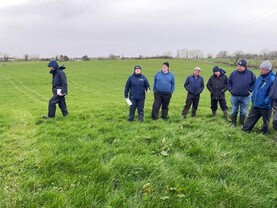For the majority of autumn-calving herds, the breeding season will take place indoors.
While this can be seen as a negative in that feed costs are higher, one positive of this system is that the farmer has complete control of the diet and it can therefore be carefully managed and tweaked, depending on what is required for each batch of cows.
Changing the diet during or just prior to the breeding season will have a detrimental effect on the reproductive performance of cows
Where there are good grass supplies on farms at the moment, the temptation may be to hold stock out at grass for an extra few weeks.
This should be done with young stock or spring-calving cows but autumn cows heading into the breeding season need to be carefully managed.
Changing the diet during or just prior to the breeding season will have a detrimental effect on the reproductive performance of cows for a period while they adjust to their new feeding system.
Having cows housed and settled on their winter diets prior to the onset of breeding is the best approach
Where this occurs during the breeding season, you will often be able to identify the changeover next year at calving time as there will be a week to 10 days of a break in cows calving. This can have a negative effect on the system, with calving periods extended or a higher number of cows empty at the end of breeding.
Having cows housed and settled on their winter diets prior to the onset of breeding is the best approach in this instance.
The cost of the winter feeding period associated with an autumn-calving system is one of the main reasons why more farmers opt for spring calving. This will be especially true this year as we see concentrate prices running €40/t to €50/t ahead of the same time last year.
However, nutrition is not an area to skimp on if you are to achieve good conception rates, a tight calving interval and support a decent level of performance in the newly born calf.
In order to minimise the feed cost implications this winter, knowing the feed value of the silage in your yard this year is more important than ever before.
Depending on the silage quality available to cows for the breeding period, you could save as much as €75/cow in concentrate costs. Over- or under-supplementing cows can be a costly mistake.
Getting a proper silage sample is really important. Don’t just take a sample from the first grab of silage taken out of the pit or from the first bale opened. To get a true measure of the quality of silage in the yard, pits or bales need to be cored multiple times. Once you receive the results, use this analysis create your winter rations.
When housing cows, do so according to body condition score. No matter what the management of cows post-calving is, some condition loss in inevitable.
However, you want cows to be on a rising plane of nutrition in the runup to breeding.
Pen thinner cows together and offer them preferential treatment. First-calvers should also be given preferential treatment in the runup to breeding and ensure that all animals have adequate space at the feed barriers so that no cow is bullied away when meal is being fed.
In this system, you really need to be working with a minimum silage quality of 70% DMD.
Below this, you will have to supplement with higher levels of meal and costs add up quite quickly.
Therefore, the best silage in the yard should be targeted at autumn cows post-calving and throughout the breeding season.
During this period, cows should not be expected to work too hard at cleaning up the last of the silage on offer. If there is a lower priority group of stock on the farm, this silage should be removed and offered to them. Keep top-quality silage available to cows at all times.
Even 70% DMD silage will need to be supplemented with 2kg/day concentrates during the breeding period. Where silage quality is poor at 65% or 66% DMD, meal feeding will need to be 3kg/day. While where silage quality is excellent – 73% or 74% DMD – meal feeding can be reduced to 1.5kg/day.
Typically, autumn-calving cow rations are going to comprise 18% protein as there is a huge demand for protein from the cow in terms of milk production.
High-energy constituents should also play a big part of rations – barley and maize being the main things to look for. Currently, a typical ration on this spec is trading at around €310/t to €320/t.
However, the specifications of the ration needed on your farm may be different depending on your silage quality and analysis.
Speak to your feed merchant about the most appropriate ration for your herd and include a good-quality mineral spec, included at a sufficient rate for the level of supplementation you intend to feed.






 This is a subscriber-only article
This is a subscriber-only article










SHARING OPTIONS: